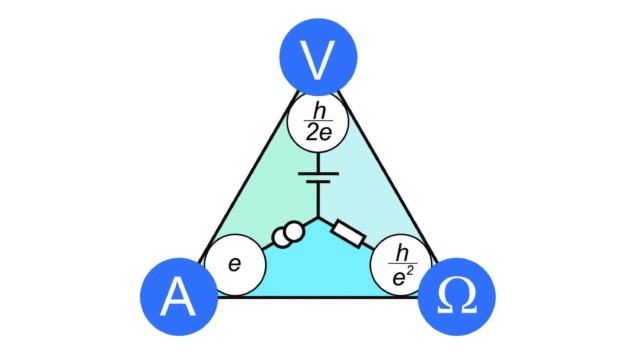
The most accurate measurements so far of voltage oscillations at a superconductor junction have been made by Sergey Lotkhov and colleagues at the German Federal Metrology Institute (PTB). The team’s approach could lead to the development of a new standard for measuring electrical current.
Frequencies can be measured and compared with very high accuracy, so metrology systems often convert physical quantities into frequencies. So far, however, the measurement of electrical currents have not benefitted from this approach.
But now, new research by Lotkhov’s team suggests that a frequency-based current standard could be created using Josephson junctions. These are a widely-used quantum devices that comprise two superconducting materials that are separated by a thin insulating barrier.
Voltage oscillations
When a constant current is fed into a Josephson junction, electron pairs will build up on one of the superconductors, unable to cross the insulating barrier. This increases the voltage across the barrier until it reaches a level where a pair can quantum-mechanically tunnel across the barrier. This tunnelling causes the voltage to drop and the process repeats itself.
The result is a steady variation in the voltage across the junction – called a Bloch oscillation. This occurs at a frequency that is proportional to the input current, so measuring this frequency could provide a very accurate way for measuring and comparing current – at least in principle. But in practice, these oscillations are very small and their frequencies have proven very difficult to measure directly. Instead, previous studies have measured them indirectly by synchronizing the oscillation with an external microwave source.
In this synchronized state, a series of plateaus called Shapiro steps appear in the voltage–current curve of a junction. These steps occur at specific current values that are proportional to exact multiples of the frequency of the applied microwave radiation. This offers a way of measuring current.
Noise problems
However, such measurements are hampered by various types of noise that occur in a Josephson junction. So far, this noise has made Bloch oscillations unsuitable for use as a robust current-measurement standard.

Electrical resistance standard could get a revised quantum definition
Now Lotkhov and colleagues have reduced the noise by using a superconducting quantum interference device (SQUID) to deliver the microwave oscillations. A SQUID comprises two strongly coupled Josephson junctions and is often used to measure tiny magnetic fields. The SQUID was integrated along with another Josephson junction in a single device that was child to 0.1 K to minimize thermal noise.
With this setup, the researchers achieved far lower levels of noise than previous microwave experiments and were able to make accurate measurements of the Bloch oscillation frequency. Crucially, the voltage-current relationship they observed displayed the same series of Shapiro steps seen in past studies. This established the link between current and Bloch frequency.
The team’s results also agree closely with simulations of the oscillations. Following the success of their approach, Lotkhov and colleagues hope their experiments could be an important next step towards a robust new measurement standard for electric current. For now, they will aim to address quantum-scale fluctuations in the SQUID, which could help them to reduce noise even further.
The new measurement technique is described in Physical Review Letters.
- SEO Powered Content & PR Distribution. Get Amplified Today.
- PlatoData.Network Vertical Generative Ai. Empower Yourself. Access Here.
- PlatoAiStream. Web3 Intelligence. Knowledge Amplified. Access Here.
- PlatoESG. Carbon, CleanTech, Energy, Environment, Solar, Waste Management. Access Here.
- PlatoHealth. Biotech and Clinical Trials Intelligence. Access Here.
- Source: https://physicsworld.com/a/quieter-quantum-device-measures-electrical-current/



